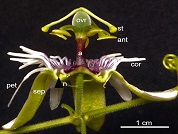Nocturnal and crepuscular pollination of Passiflora morifolia (Passifloraceae): breeding system, floral biology and pollinators
DOI:
https://doi.org/10.14522/darwiniana.2022.101.1015Keywords:
Atlantic Forest, crepuscular bees, nocturnal bees, self-compatibilityAbstract
The study of interactions between plants and animals is important for detecting the degree of vulnerability of species under the current scenario of forest fragmentation. The genus Passiflora (Passifloraceae) is widely distributed in forest formations in Brazil with about 157 species. Here we studied the pollination biology of Passiflora morifolia, a native species of Brazil that is widely distributed in the American continent. Floral biology observations, controlled pollination tests and the recording of floral visitors were carried out in an area of natural occurrence, a fragment of Araucaria Moist Forest, located in the state of Paraná, Brazil. The results showed that the species is self-compatible, with flowers that open at night and remain open and receptive in the morning. The greatest volume of secreted nectar was observed at the beginning of anthesis, when the flower released an intense sweet odor and received visits from nocturnal and crepuscular bees. The bees Megommation insigne and Ptiloglossa willinki were the first visitors to the opened flowers and also the main pollinators.

Downloads
Published
How to Cite
Issue
Section
License

Starting on 2012, Darwiniana Nueva Serie uses Licencia Creative Commons Atribución-NoComercial 2.5 Argentina .





